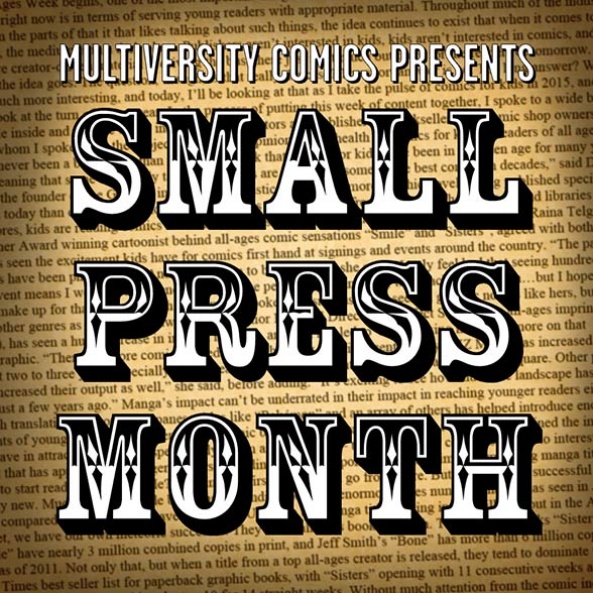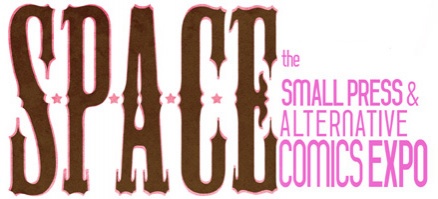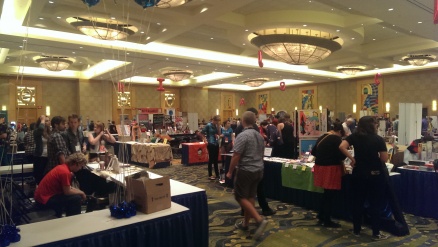
A month long look at small comic publishers wouldn’t be complete without considering the personal interactions between creators and readers at annual conventions. In all the hustle and bustle of the major conventions, many of the smaller ones go under the radar. This is especially true of the cons centered on small press, which are almost as unknown as the books being sold at them.
As mentioned in the History of Independent Comics article yesterday, the first small press conventions were founded to counter a growing issue with the mainstream cons. Dan Vado, the founder of the Alternative Press Expo (APE), specifically points to the DC booth at SDCC ’93 as the tipping point for him. He says its size may be considered quaint by today’s standards, but at the time it was larger than anything he’s previously seen at a con. You don’t have to look far to find anecdotal evidence that this problem has only gotten worse in the last 20 years – Hollywood’s infestation of SDCC has been a perennial complaint for some time now.

Deciding to be the instrument of change himself, Vado started APE in 1994. It attracted just under 500 paying attendees and he considered it to be off to a very good start, but he knew his duties as head of Slave Labor Graphics would prevent him from making it what it needed to be. He had actually canceled the 1995 event when Comic-Con contacted him asking if they could help. Trusting their experience and commitment, he handed it over to them. He was still involved with running it until it was moved from San Jose to San Francisco in 2000. In 2014, attendance was around 6000, although it’s not clear how much of that number was guests who got free admittance with an SDCC badge or if guests who attended more than one day were double counted. Beginning this year, APE will be back under Vado’s full control.

The other con to debut in 1994 was the Bethesda-based Small Press Expo (SPX). It was initially founded by retailers in the Washington DC / Maryland area. Warren Bernard, who had started with the expo as a volunteer in 2002, became the executive director in 2011. Knowing the primary demographic attending the show were readers in their 20s and 30s, he made a commitment to keeping the show affordable. Space and tables are limited at SPX, but the show maintains an application process that ensures everyone has a chance at exposure, even if they’ve been making comics for only one day. If a creator had a table previously, curating judges might even grant them an automatic table for the next event. If they aren’t offered that, they go into a lottery with every other applicant. If a creator isn’t an instant winner through the lottery, they’re put on a waiting list.

The following year, Dave Sim of “Cerebus” fame began a year long Spirits of Independents tour, with the first stop in Columbus, Ohio. The show made quite an impression on self-publisher Bob Cordy, who had been presenting at conventions since 1988. By the end of the millennium, Cordy had become frustrated by the predominance of movies, wrestlers, and the like at mainstream cons, so he contacted Sim about reviving the Spirits show. Sim gave his blessing, but would be unable to appear due to do his busy schedule. Not wanting to use Sim’s name if Sim couldn’t attend, Corby decided to name his show the Small Press and Alternative Comics Expo (SPACE). The first show did poorly, but the second one received a shot in the arm when Sim wanted to attend and use the con to deliver the first Howard Eugene Day Memorial Award. Since then, show attendance has grown by 10% or more every year but one.
These aren’t the only small press conventions. Since 2002, New York’s Museum of Comic and Cartoon Art (MoCCA) has held an annual festival with attendance over 2000. The Chicago Alternative Comic Expo (CACE, pronounced like ‘cake’) is a relatively new show, but it’s free admission and offer of actual cake to exhibitors has accounted for rapid growth over the last three years. There’s also TCAF in Toronto, the St. Louis Small Press Expo in Missouri, and many others around the country.
Continued belowDespite the wide variety of the conventions, talking to attendees reveals a number of similarities in the experiences. On the exhibitor side of things, these expos offer the chance to network with other creators. Sometimes this means finally meeting face to face with someone they’ve been talking to online for years. Other times, it means making new friends with the people who have been assigned to nearby tables. The financial success of small press conventions varies widely, and can depend heavily on how high travel expenses are. Losing money on the trip isn’t always seen as a bad thing because, unlike mainstream conventions, some exhibitors are as interested in trading their work for other books as they are pocketing cash. These kinds of deals can end up working better than plain sales through a multiplier effect; if the traded book impresses the other creator, they’re likely to promote it to their own fans.

Small press conventions also offer exhibitors a different kind of clientele. At a mainstream convention, an exhibitor may struggle to grab the attention of an attendee who’s not there find something new. At a small press con, pretty much every guest has arrived with an open mind and fewer preconceived notions about where they’re spending their money. The demographics are also different. Small press cons tend to have more diversity in age and gender, for both exhibitors and attendees. They are still predominantly white, though.
Likewise, small press conventions offer attendees a different type of show as well. Aside from the obvious absence of other media and barrage of advertising, there’s also a noticeable lack of cosplayers and book dealers. By and large, everyone is there to sell their own material, not the work of others. That’s not quite universal because publishers like Top Shelf do attend to push their line, but as far as tables filled with long boxes of old single issues go? Forget about it. This alteration in setup takes interaction between readers and creators from optional to required. Essentially, the entire con is one big Artist Alley. Most of the small cons also offer programs and panels, but they’re less about publishers making announcements and more about education and commentary on existing works.
If you’ve never been to a small press con, they’re worth looking into. They’re more affordable than a mainstream con, and by most accounts they offer an unbeatable experience. Everyone involved is there out of love of the craft, and the pure motives create a tangibly positive atmosphere. Some people, like Roger Langridge and Seth T Hahne, even found the shows inspirational. After Langridge’s first trip to SPX, he made the big decision to turn his web comic into print. Hahne attended SPX 2013 as a fan, and his experience moved him to create his own comic. What’s more, he followed through with it. He returned to SPX the next year as an exhibitor.
Imagine how attending a small press con may affect you…






